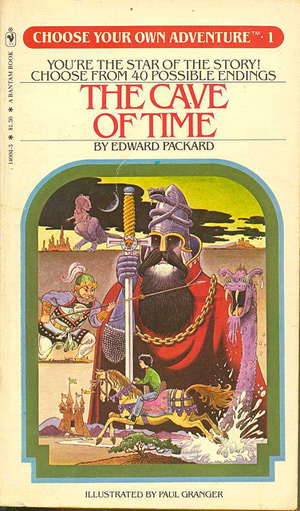Choose your own adventure
Posted on 24 September 2012
Choose your own adventure
 By Heather Packer, Agent and Research fellow at the University of Southampton.
By Heather Packer, Agent and Research fellow at the University of Southampton.
When I was around the age of ten, I remember reading books where you could make decisions that would influence the story. I hadn't given this much thought until I attended the Narrative and Hypertext workshop. At the workshop, I saw various systems that allowed people to author a story using hyperlinks to develop or explore a narrative. Why isn't this kind of storytelling more widespread? I haven't yet found any such books for my Kindle Touch.
Authoring hypertext fiction is less straightforward than an ordinary linear narrative, and it can be difficult to write without specialist software. Hypertext narrative software enables authors to create, order and manage the relationships between plots and characters. Traditionally, hypertext fiction authoring tools have been very expensive, for examples StorySpace, which costs $295. It seems that this is one reason why hypertext fiction has not seen more widespread use. There is free open source software, such as HypeDyn which runs on all major platforms, but it seems to have fewer features than the commercial software. The availability of software alone is not likely to trigger a surge of new fiction, but it should help to alleviate one of the obstacles that face potential hypertext authors.
Authoring a hypertext narrative is difficult. I've tried with simple short stories of less than three thousand words. A successful story requires the manipulation of tension. This can be difficult because there is a trade-off between using too many and too few nodes (the relationships and choices in the direction of the plot). Using too many makes it difficult to develop suspense and crescendos. Using too few means that the author does not benefit from the full effect of using hypertext narratives as a storytelling device.
An obvious challenge in writing a non-linear story is keeping track of events and characters. It is possible to leave loose ends, which will leave the reader lost and confused. This problem can be addressed by setting rules, where different states are triggered based on past events, in order to maintain plot integrity. The authoring tool manages and enforces these rules, thus helping the author to meet their own set rules. In the article Adaptivity in Hyperfiction, Licia Calvi presents the challenges in setting conditional rules and investigates how this affects the relationship between reader and author.
Writing a hypertext narrative is about organisation and creativity, and these two factors seem disconnected. The more complex a narrative, the more important it is that a hypertext system can support creativity without burdening the author with organisation and remembering key details. Hypertext narrative software could automatically suggest interactions between the current protagonist and characters that may have had their thread dropped. This could prompt the author to weave different threads together or keep them in mind for other story plots.
That said, hypertext narratives are not linear. Maybe we should not box them in and compare them to a traditional narrative. Mark Bernstein argued that we needed new hypertext tools to help us break away from the expected, and explore new artistic spaces.
If you are interested in hypertext narrative systems, I suggest visiting the websites Strange Hypertexts, Interactive Story or Authoring Story. There is also a good description on Wikipedia.

